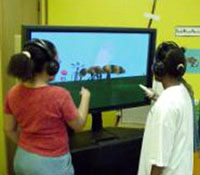A Two-Tiered Collaborative Design for Observational Science Activities in Simulated Environments
January 7th, 2002
Categories: Applications, Education, Multimedia, Tele-Immersion

Authors
Moher, T., J. Kim, D. HaasAbout
Elementary school science focuses on the early phases of science inquiry: observation, description, data collection, reflection, and reporting. Technologies afford opportunities to scaffold and extend the domains of inquiry, but successful adoption depends on their integration with classroom organization and practice.
In elementary schools, small group and whole class activities dominate over solitary activity, and the effective use of traditional desktop computer systems has proven to be a difficult challenge for classroom teachers.
Increasingly affordable large-format displays more naturally support small-group collaboration, but require careful activity design to maximize utility. We describe an activity design employing large displays that accommodates both the constraints of the classroom and the play experiences of children in support of observational science learning.
Resources
URL
Citation
Moher, T., J. Kim, D. Haas, A Two-Tiered Collaborative Design for Observational Science Activities in Simulated Environments, Computer Support for Collaborative Learning (CSCL) 2002, Boulder, Colorado, pp. 361-370, January 7th, 2002. http://www.evl.uic.edu/moher/ii/CSCL2002.htm